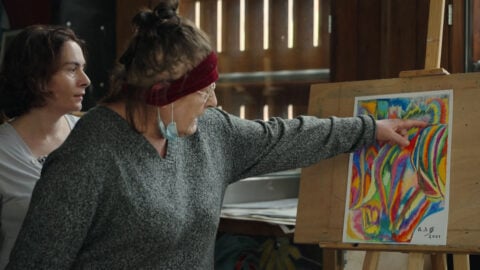Film of the Week: Spectre
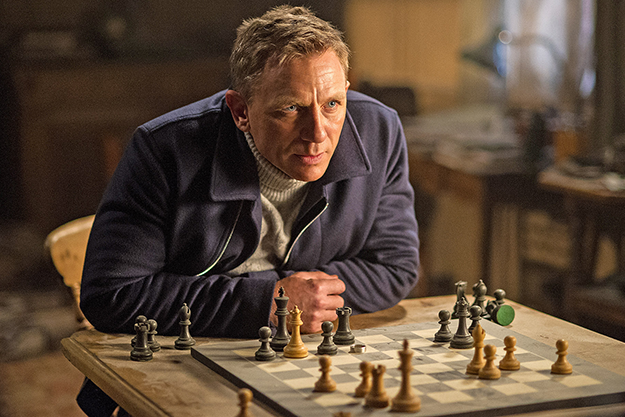
James Bond matters a lot in the U.K. You can tell by the British box-office figures for his latest outing Spectre: £41.3 million ($63.15 million), since its release on October 26. You can also tell by the hyperventilating enthusiasm of British critics in general, many of them males of a certain age—by which I mean that the modified Aston Martin that 007 drives in this film will remind them unfailingly of the Sixties Corgi toy Bond cars that my generation eagerly collected. Yes, nostalgia has a lot to do with the appeal of Spectre—it’s no accident that its heroine, played by Léa Seydoux, has the brazenly Proustian name Madeleine Swann.
Let me say that I half share my colleagues’ enthusiasm for Spectre—personally, I had my own unexpected burst of belated 007 enthusiasm with Skyfall, arguably the most elegant, sophisticated Bond film ever. And for me, Spectre is no Skyfall. Still, Sam Mendes has once again brought a lavish feast of effects to the table, and applied them with seriousness and grace, as well as the mandatory brio. You won’t be disappointed—well, not too disappointed.
What’s most interesting about this episode of the series is the way that it’s concerned, very unusually, to offer some sort of closure or finality. The closing credits end, as ever, by telling us that Bond will be back, but the film constantly raises the possibility that perhaps he won’t—or at least, not as Daniel Craig, who has been fairly cantankerous when asked about the prospect of playing the part again. The narrative proper—after an extended action prelude, and Daniel Kleinman’s title sequence, big on octopi and symmetry—begins with Bond’s boss, the peppery new M (Ralph Fiennes), warning him that the British government is thinking of wrapping up the licensed-to-kill “00” category of operatives. No Double-O, no Bond—can it be?
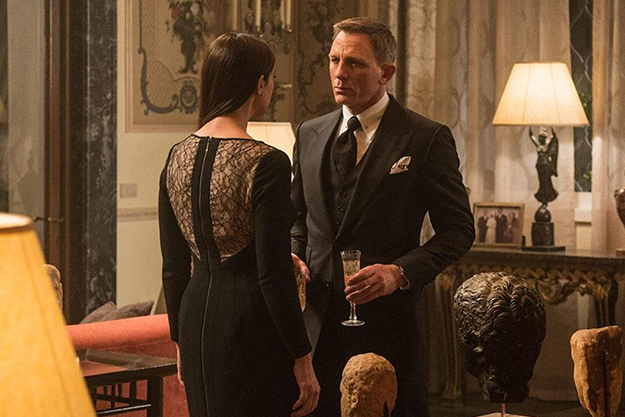
Of course Bond is indestructible, that’s the point. But it’s a certain kind of indestructibility that makes him, and the series, interesting. There’s only a year between the first Bond film, Dr. No (62), and the start of the BBC TV series Doctor Who (63). As heroes, Bond and the time-traveling Doctor have one obvious thing in common: they each represent a last line of defense, a final bastion of strength, faith and ingenuity, each one alone capable of (repeatedly) saving the world. Each also has the capacity to regenerate. The Doctor, an extraterrestrial, can actually transform his body, with each mutation also radically and unpredictably changing his personality—which has proved an ingenious way to keep the series going despite 12 different actors playing the lead.
Bond, as we know, also regenerates: that is, he can be recast. But unlike the Doctor, whose age, appearance, and manner fluctuate wildly, he also stays essentially the same. Daniel Craig may be very different from Sean Connery, who was very different from Roger Moore or Pierce Brosnan or Timothy Dalton (although the problem with George Lazenby was that he was too similar to the Connery prototype, in a pale carbon-copy way, to be remotely interesting). But the actors always cohere within strict limits to a template: a white British male (although rumors persist that he won’t always be white), taciturn but prone to the odd wisecrack, unstoppably athletic but unflappable, self-contained enough to go through hell without ever breaking a sweat, and always ready to slip back into a fresh tux (can you imagine Bond smeared with grit in a singlet, like Bruce Willis in Die Hard?).
Some Bond films have tried to give 007 an inner self: On Her Majesty’s Secret Service and Casino Royale, where he suffers the pangs of lost love, and Skyfall, centered on his Oedipal relation to authority, as embodied by Judi Dench’s M. Spectre similarly gives Bond a troubled past—troubled pasts, and the Unresolved Issues that accompany them, being mandatory these days, whether for The Doctor, Harry Potter, or the Marvel pantheon of heroes. But frankly, who cares? Bond doesn’t need much character nuance. What’s his motivation? Tenacity, moral certainty, and the merest soupçon of Martini-dry wit. Now get on with it.
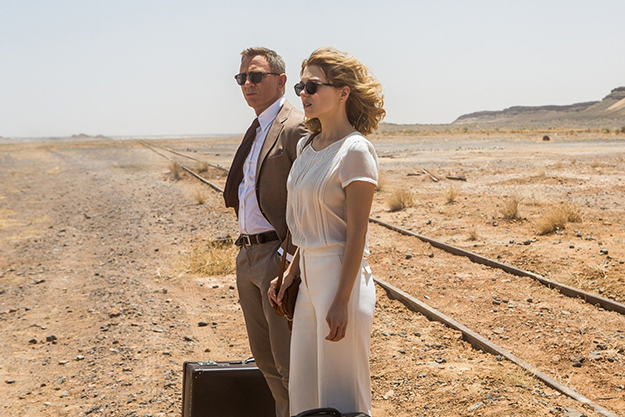
So the whole business of Spectre being built on the principle of looking back seems to me essentially pointless. In the past, Bond films simply succeeded each other, leaving no trace from episode to the next. Characters have recurred, but each episode essentially started as a tabula rasa, just as each sequence within each film seemed to have no real relation to the ones that preceded it: the films are structured like musicals, a succession of novelty numbers, with the big production number usually at the end (but sometimes, as here, right at the start).
In Spectre, though, Mendes and writers John Logan, Neal Purvis, Robert Wade, and Jez Butterworth seem determined to convey the sense of some continuity coming to a climax, of things being wrapped up retrospectively. There are overt references to Casino Royale (06), Quantum of Solace (08)—including the return of Jesper Christensen’s Mr. White—and Skyfall, with previous villains Mads Mikkelsen and Javier Bardem glimpsed in the opening credits. This film’s villain, played by Christoph Waltz, turns out to have been secretly pulling the strings in the previous few episodes. And Spectre overtly positions itself as a sequel to Skyfall, with that film’s destruction of the MI6 HQ having major plot repercussions here.
Meanwhile, the film hangs obsessively on the theme of the returning past. The plot is very much about Bond’s secret connection with this film’s bad guy, Franz Oberhauser (Waltz), who is not who he appears to be (look, I’m not going to spoil it for you, but his true identity was rumored the moment the film was announced; let’s just say the Persian cat has long been out of the bag). There’s even a malign muscle man—Mr. Hinx, played by Dave Bautista—who manifestly harks back to the monolithic thuggery of Richard Kiel’s Jaws and Harold Sakata’s ineffable Odd Job. Bautista is one of the best things here, because he’s so utterly businesslike: Hinx’s idea of presenting his credentials for a job is to calmly gouge out the other candidate’s eyes.
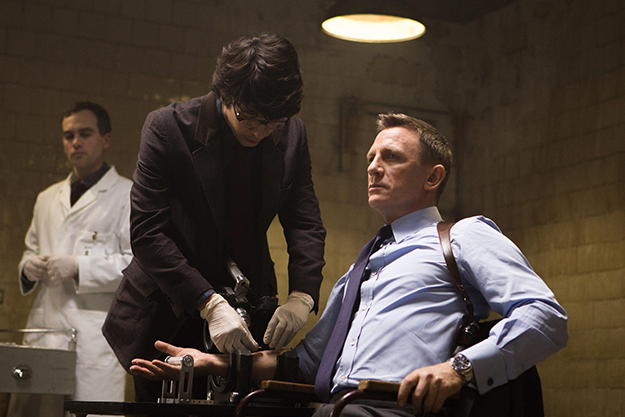
Then there are all the little in-jokes that started as far back as the Connery years, but became a painfully knowing between-chums affair during Roger Moore’s tenure. At the bar of a steel-and-glass clinic in Austria, Bond orders his usual tipple, shaken but not stirred, but is instead offered some hideous green health concoction. Later, on a Moroccan train—on which he wears an impeccable white tux by Tom Ford, presumably from his “Mythic Archetype” collection—Madeleine Swann trumps him, by ordering a vodka Martini (a little different, a little louche), then adding “dirty.”
It wasn’t until the final showdown between Bond and Oberhauser that I realized that Spectre concluded an “origin story” of sorts, explaining how Oberhauser acquired what would become his character’s trademarks, later in his career. That makes sense, if you regard 2006’s Casino Royale—based, after all, on Ian Fleming’s first Bond novel—as a reboot of the series, wiping the slate clean and starting again. That would explain why only the Daniel Craig episodes are overtly alluded to here, not any of their predecessors.
Of course, when you’re dealing with a series whose essence is the evocation of a kind of timelessness, it doesn’t really make sense to evoke such modern ideas as the “reboot”—and that’s why Spectre so intrigues. It plays with the idea of linear, casual time, by linking the recent episodes, and by evoking, like Skyfall, the idea of Bond’s pre-007 biography. But it also sustains the sense of sterling immutability which is the essential keystone of the Bond myth—and which is its unique selling point now, when we’re numbed and confounded by the constant casual renewability of myths (see what threatens to be the endless returns to point zero of the Spider-Man property). The idea of a hero who’s basically forever the same, whoever plays him, is immensely appealing.
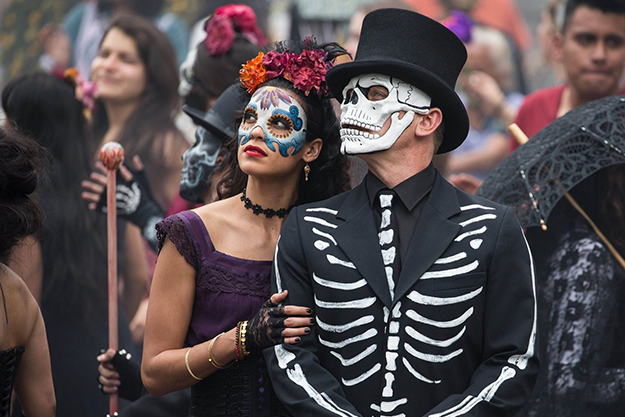
Not that Craig isn’t different from his predecessors; let’s say he’s a twist on the same recipe, in the same way that someone might prefer to make a Martini with a different brand of vermouth. While Casino Royale presented him as rather lunkishly brutal, Sam Mendes’s two episodes have brought out an interesting tension: Craig’s Bond still looks and reacts like a scowling thug, but he has an almost feminine softness in his speech. And where Moore’s Bond would have ostentatiously flexed an eyebrow at the in-jokes, Craig has a way of looking a little weary, almost wincing when Spectre’s occasional gags (which are quite subtly pitched) come along.
Spectre offers plenty to enjoy, to be sure. The opening sequence in Mexico City starts with a dazzling plan-séquence, possibly a direct tribute to the Mexican long-take bravura of Alfonso Cuarón and Emmanuel Lubezki (although they’d have run the shot a lot longer). And the Rome sequence, with Monica Bellucci as a mob widow who seems to have inherited the vintage lingerie style of Sophia Loren, in turn carries visual echoes of The Conformist, The Great Beauty, and The Italian Job. This is the most film-literate Bond movie yet in terms of its borrowings—the secret society Spectre holds its meetings in the same kind of palace as we saw in Eyes Wide Shut, and at one point, Seydoux’s moody exit in a trench coat puts you irresistibly in mind of Alida Valli in The Third Man. But the best borrowings are from the Bond series itself, with Oberhauser’s desert lair unfailingly recalling the great Bond sets designed by Ken Adam in the Sixties and Seventies.
Production designer Dennis Gassner and DP Hoyte Van Hoytema pull off some marvels here, although I missed the sheer vividness of color of Roger Deakins’s photography in Skyfall (that crazy lightbox of an glass office building!). There’s a visual restraint here that somehow dampens the tone—those caramels and desert browns, that simply too subtle dusty blue in Léa Seydoux’s evening dress.
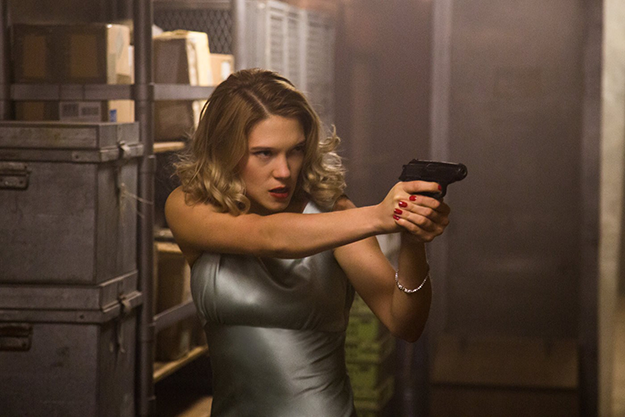
In short, I wanted more visual noise—a little vulgarity, even. The problem may be that Mendes is trying to offset the inherent pulpiness of the series by playing up the class. When it comes to playing the sophistication card, Léa Seydoux is perhaps the best example of that—her quintessentially Euro siren is a little too quietly frosty to ever catch fire, although there’s still something irresistible about the way she points her snub nose at the camera with perfect Left Bank contempt. Overall, the casting couldn’t be tonier: Waltz is impishly insouciant, Ben Whishaw continues to play Q as the eternal graduate-studies boffin, and Ralph Fiennes gives his spymaster M something new to the series, a touch of the dry-mannered solitude you tend to associate with John le Carré’s George Smiley.
The basic premise revolves around the idea of traditional 007-style spying being superseded by the real spectre that’s currently haunting us all: the prospect of permanent surveillance. That’s the contemporary theme introduced to a classic formula—and the only reason it doesn’t come across more strikingly as a radical novelty is because the theme has already turned up as a key element in, of all things, Captain America: The Winter Soldier. Be that as it may, Spectre gives the topic serious weight, but the theme of spying old vs. new finds its most intriguing expression when Bond and Madeleine discover a secret chamber in a Tangiers hotel. It contains old photos, dusty passports, videotapes—the paraphernalia of old-school spying, of the pre-digital age, of the era of La Carré’s seedy, scuffed civil servants. It’s espionage older than Bond itself—and it’s hard not to feel a lump in the throat at this moment, as this scene unearths the relics of an antique genre that still has the power to entrance us. That’s perhaps what Spectre really means by its opening caption “The dead are alive…”—or to rephrase the title of an earlier film in the series, Yesterday Never Dies.






